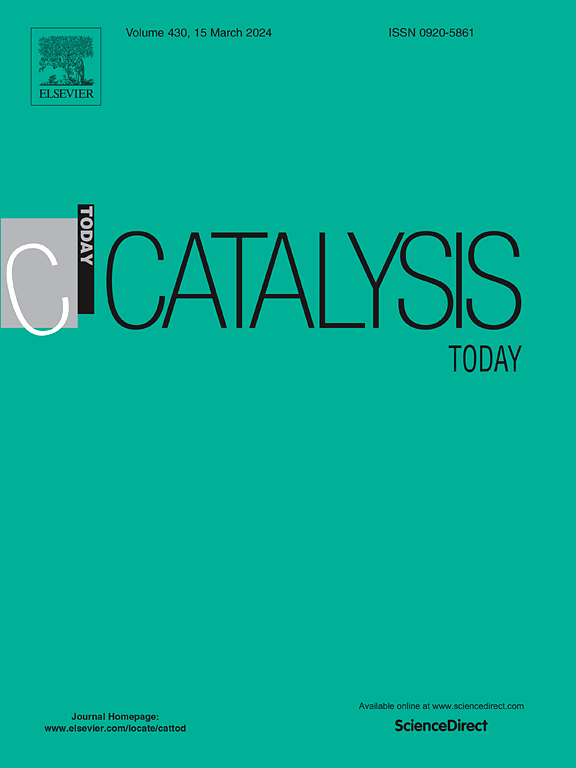Iron minerals as catalysts in photo-assisted NO3– reduction in aqueous phase
IF 5.2
2区 化学
Q1 CHEMISTRY, APPLIED
引用次数: 0
Abstract
Presence of nitrogenous compounds in drinking water cannot exceed 50 mg/L for NO3−, 0.1 for NO2−, and 0.5 mg/L for NH4+. In order to address this issue, this study tackles the use of iron-rich minerals (hematite, ilmenite, goethite and magnetite) as catalysts in photo-assisted nitrate reduction employing oxalate as reducing agent. Firstly, the catalytic activity of the different minerals was tested at different pH levels, finding an outstanding performance of magnetite at pH0 5, with a 50 % NO3− reduction in 60 min. After selecting magnetite as catalyst, a parametric study was performed evaluating initial pollutant concentration, catalyst load and reducing agent dosage. Best operating conditions were found to be [NO3−]: 75 mg/L, [Fe3O4]: 100 mg/L, [C2O42−]: 370 mg/L and pH0 5, for which complete NO3− reduction and selectivity towards N2(g) was reached after 150 min. Furthermore, magnetite maintained its activity in 5 consecutive cycles without any treatment between runs, showing its great stability. Reaction mechanism follows two pathways: i) direct electron transfer and ii) CO2• − mediated reduction. This mechanism was validated using methyl viologen as CO2• −scavenger showing that both pathways contribute equally in NO3− reduction. Finally, process feasibility was tested employing real groundwater samples naturally containing NO3−, showing promising results towards the implementation of photo-assisted catalytic reduction for drinking water treatment. Thus, a highly efficient technology has been developed, overcoming the limitations of photo-assisted nitrate removal processes by utilizing a cost-effective, stable, and highly active catalyst. This approach achieves the legislation for drinking water while generating negligible [NH4+].
铁矿物在光辅助水中NO3 -还原中的催化作用
饮用水中氮化合物的含量NO3−不能超过50 mg/L, NO2−不能超过0.1 mg/L, NH4+不能超过0.5 mg/L。为了解决这一问题,本研究以草酸盐为还原剂,利用富铁矿物(赤铁矿、钛铁矿、针铁矿和磁铁矿)作为催化剂进行光辅助还原硝酸盐的研究。首先,对不同矿物在不同pH水平下的催化活性进行了测试,发现磁铁矿在pH0 - 5条件下表现优异,在60 min内还原了50% % NO3−。选择磁铁矿作为催化剂,对初始污染物浓度、催化剂负荷和还原剂用量进行了参数化研究。最佳操作条件为[NO3−]:75 mg/L, [Fe3O4]: 100 mg/L, [C2O42−]:370 mg/L, pH0 5,在150 min后达到完全的NO3−还原和对N2(g)的选择性。此外,磁铁矿在连续5个循环中保持活性,无需在两次运行之间进行任何处理,显示出很强的稳定性。反应机理遵循两个途径:i)直接电子转移和ii) CO2•−介导的还原。这一机制得到了验证,使用甲基紫紫素作为CO2•−清除剂,表明这两种途径对NO3−还原的贡献相同。最后,利用天然含NO3−的真实地下水样品对工艺可行性进行了测试,显示了光辅助催化还原用于饮用水处理的良好结果。因此,一种高效的技术已经被开发出来,通过利用一种经济、稳定和高活性的催化剂,克服了光辅助硝酸盐去除工艺的局限性。这种方法在产生可忽略不计的[NH4+]的同时实现了对饮用水的立法。
本文章由计算机程序翻译,如有差异,请以英文原文为准。
求助全文
约1分钟内获得全文
求助全文
来源期刊

Catalysis Today
化学-工程:化工
CiteScore
11.50
自引率
3.80%
发文量
573
审稿时长
2.9 months
期刊介绍:
Catalysis Today focuses on the rapid publication of original invited papers devoted to currently important topics in catalysis and related subjects. The journal only publishes special issues (Proposing a Catalysis Today Special Issue), each of which is supervised by Guest Editors who recruit individual papers and oversee the peer review process. Catalysis Today offers researchers in the field of catalysis in-depth overviews of topical issues.
Both fundamental and applied aspects of catalysis are covered. Subjects such as catalysis of immobilized organometallic and biocatalytic systems are welcome. Subjects related to catalysis such as experimental techniques, adsorption, process technology, synthesis, in situ characterization, computational, theoretical modeling, imaging and others are included if there is a clear relationship to catalysis.
 求助内容:
求助内容: 应助结果提醒方式:
应助结果提醒方式:


